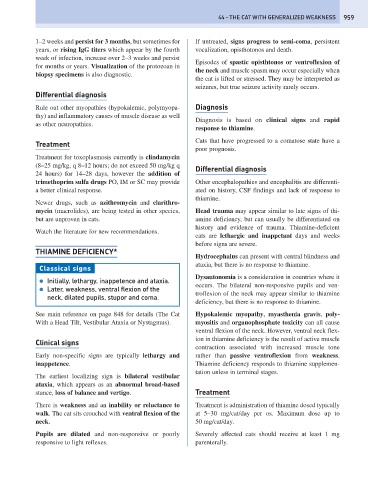Page 967 - Problem-Based Feline Medicine
P. 967
44 – THE CAT WITH GENERALIZED WEAKNESS 959
1–2 weeks and persist for 3 months, but sometimes for If untreated, signs progress to semi-coma, persistent
years, or rising IgG titers which appear by the fourth vocalization, opisthotonos and death.
week of infection, increase over 2–3 weeks and persist
Episodes of spastic opisthtonos or ventroflexion of
for months or years. Visualization of the protozoan in
the neck and muscle spasm may occur especially when
biopsy specimens is also diagnostic.
the cat is lifted or stressed. They may be interpreted as
seizures, but true seizure activity rarely occurs.
Differential diagnosis
Rule out other myopathies (hypokalemic, polymyopa- Diagnosis
thy) and inflammatory causes of muscle disease as well
Diagnosis is based on clinical signs and rapid
as other neuropathies.
response to thiamine.
Cats that have progressed to a comatose state have a
Treatment
poor prognosis.
Treatment for toxoplasmosis currently is clindamycin
(8–25 mg/kg, q 8–12 hours; do not exceed 50 mg/kg q
Differential diagnosis
24 hours) for 14–28 days, however the addition of
trimethoprim sulfa drugs PO, IM or SC may provide Other encephalopathies and encephalitis are differenti-
a better clinical response. ated on history, CSF findings and lack of response to
thiamine.
Newer drugs, such as azithromycin and clarithro-
mycin (macrolides), are being tested in other species, Head trauma may appear similar to late signs of thi-
but are unproven in cats. amine deficiency, but can usually be differentiated on
history and evidence of trauma. Thiamine-deficient
Watch the literature for new recommendations.
cats are lethargic and inappetant days and weeks
before signs are severe.
THIAMINE DEFICIENCY*
Hydrocephalus can present with central blindness and
ataxia, but there is no response to thiamine.
Classical signs
Dysautonomia is a consideration in countries where it
● Initially, lethargy, inappetence and ataxia.
occurs. The bilateral non-responsive pupils and ven-
● Later, weakness, ventral flexion of the
troflexion of the neck may appear similar to thiamine
neck, dilated pupils, stupor and coma.
deficiency, but there is no response to thiamine.
See main reference on page 848 for details (The Cat Hypokalemic myopathy, myasthenia gravis, poly-
With a Head Tilt, Vestibular Ataxia or Nystagmus). myositis and organophosphate toxicity can all cause
ventral flexion of the neck. However, ventral neck flex-
ion in thiamine deficiency is the result of active muscle
Clinical signs
contraction associated with increased muscle tone
Early non-specific signs are typically lethargy and rather than passive ventroflexion from weakness.
inappetence. Thiamine deficiency responds to thiamine supplemen-
tation unless in terminal stages.
The earliest localizing sign is bilateral vestibular
ataxia, which appears as an abnormal broad-based
stance, loss of balance and vertigo. Treatment
There is weakness and an inability or reluctance to Treatment is administration of thiamine dosed typically
walk. The cat sits crouched with ventral flexion of the at 5–30 mg/cat/day per os. Maximum dose up to
neck. 50 mg/cat/day.
Pupils are dilated and non-responsive or poorly Severely affected cats should receive at least 1 mg
responsive to light reflexes. parenterally.

